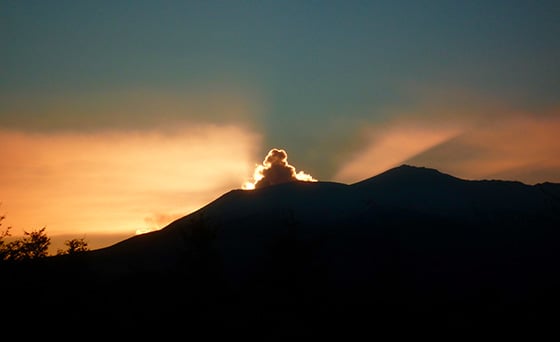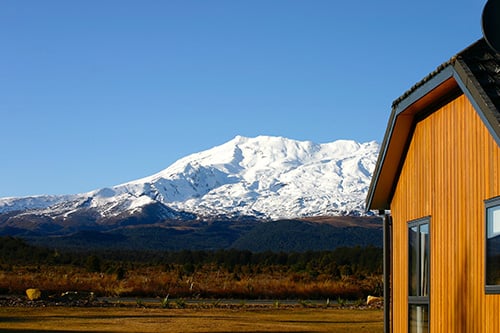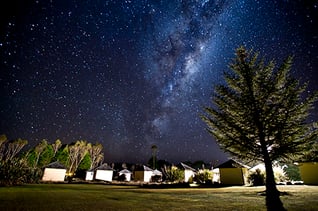The Ultimate Tongariro Crossing Planning Guide
- Section 1 The Tongariro Alpine Crossing: an overview
- Section 2 Is the Tongariro Crossing for you ?
- Section 3 Tongariro Crossing track description
- Section 4 Tongariro Crossing Map
- Section 5 Tongariro Crossing Elevations
- Section 6 Planning your Tongariro Crossing adventure: what you need to know
- Section 7 Hazards, risks & problems
- Section 8 Tongariro Crossing weather: what you need to know
- Section 9 Tongariro Crossing shuttles
- Section 10 Villages & towns near the Tongariro Crossing
- Section 11 Tongariro Crossing accommodation: close to the start
- Section 12 Tongariro Crossing camping: close to the start
- Section 13 Tongariro Crossing seasons
- Section 14 Tongariro Crossing winter experience
- Section 15 When's the best time to start the hike
- Section 16 Tongariro Crossing hiking gear
- Section 17 Food & Water
- Section 18 Tongariro Crossing alternatives
The Tongariro Alpine Crossing: an overview
| Location: | Tongariro National Park, Central North Island, New Zealand |
| Start: | Mangatepopo Road, off State Highway 47 |
| Finish: | Ketetahi Road, off State Highway 46 |
| Highlights: | Glacial valleys, active volcanos, craters and vents, ancient lava flows, coloured lakes, mountain streams, tussock lands, rain forest, long ranging views |
| Logistics: | Point to point hike, so you'll need a shuttle or someone for the drop off and pick up |
| Shuttle: | Required if you don't have someone to drop you off and pick you up |
| Distance: | 19.4 km (12.1 miles) |
| Ascent: | 748 m (2454 ft) |
| Descent: | 1108 m (3636 ft) |
| Highest point: | 1868 m (6129 ft) above mean sea level, Red Crater peak |
| Average time: | Between 7 & 8 hours with breaks & photo stops. Actual walking time is around 5hr 30 min at an average walking pace |
| Fitness: | A good level of fitness required |
| Season: | Late October to the end of May (depending on snow and ice) |
| Winter: | The track is covered in snow and ice. Climbing over Red Crater can be challenging. Ice axe and crampons are required. There is avalanche risk at times. If you don't have alpine experience taking a guided tour is the safest option |
| Open or closed: | Department of Conservation close the track during volcanic unrest. The track is not closed due to bad weather |
| Weather Advisory: | Department of Conservation & NIWA publish a weather advisory on poor weather days. DOC will recommend not hiking the Crossing on these days |
| Essential gear: | Good quality waterproof rain jacket, plenty of warm layers, sturdy footwear, sun protection, food & water, map |
| Water: | No safe drinking water along the track |
| Food: | No food available along the track. No food at the start or the finish |
| Facilities: | There's a small shelter at both ends of the Crossing. There are toilets at the start and finish, and along the track. See map below for toilets. |
| Car parking: | Minimal car parking at both ends. A four hour limit applies from Labour weekend in October to the end of April |
| Guide required: | Not during summer months. Required during winter months if you don't have alpine experience. |
| Cost: | Free to hike the track. Shuttles cost between $35 to $70 return |
| Risks: | Weather is changeable, forecast can be wrong. Chance of volcanic activity without warning. Snow and ice during winter months |
| Problems: | The weather is often underestimated. The track is popular so can get crowded. It can be difficult to choose a shuttle to meet your needs. There's a lot of down hill with steps. Hikers underprepared, not having the right gear or the fitness |
| Tribal lands of: | Ngāti Hikairo ki Tongariro, hāpu of Ngāti Tūwharetoa |
| Māori Chief: | Sir Tumu Te Heuheu |
| Weather forecasts: | Niwa, Metservice |
| Reviews: | Tripadvisor reviews |
| Live Webcam: | Tongariro webcam, Te Maari webcam, Ngauruhoe webcam, Ruapehu & Ngauruhoe |
| Suitability for children: | Yes, but only for fit, active kids who are accustomed to hiking in mountains. They must be well prepared |
| Last volcanic eruption: | Te Maari Crater eruptions of August 2012 & November 2012 |
| Mobile coverage: | Most of the track has mobile coverage, but not for all networks. Spark & Vodafone are the strongest |
| Map: | Topographical map of the Tongariro Crossing |
| Comparisons: | No other one day hike in New Zealand compares. The volcanic landscape and scenery is unique |
| Pro tips: |
Arrive the night before. Choose accommodation close to the trail head to minimise travel time to the Crossing in the morning. Start early to avoid the crowds and heat during hot sunny days. |
For your convenience download the PDF version
Click the button below and we'll email the PDF version to you.
Is the Tongariro Crossing for you ?
Here's how you know if the Tongariro Crossing is for you:
- You're healthy
- You can easily walk 10km without any problems
- You enjoy nature and mountains
You must have the right gear. If you don't, you'll need to rent or buy the gear required.
The Tongariro Alpine Crossing is 19.4 km, with 748 m ascent and 1108 m decent.
You'll complete most of the ascent in two climbs.
A 1 km flat section across the South Crater breaks up the two climbs.
This gives your legs a much welcomed rest after the first climb.
See the track description below.
Who is this hike not for ?
If you're not fit enough to easily hike 10 km the Tongariro Crossing is not for you.
Not at the moment at least.
That's not to say you can't enjoy this hike in the future.
No better time than today to start some old fashioned hard work.
Get outside and start walking. No excuses. Start today.
Here are some other reasons not to attempt the Crossing at the moment:
-
You have health issues which could prevent you from finishing.
-
You prefer complete solitude when out amongst the mountains. It's a busy track !
-
You suffer from a bad knee(s). It's a long way down, even for good knees !
-
You're not comfortable about heights. Vertigo can effect people at the top of the Red Crater.
Still unsure whether the Crossing is for you or not?
Schedule a zoom call with Callum Harland (the author) to discuss.
Callum has 20 years experience of helping people enjoy the Tongariro Crossing.
Fitness for the Tongariro Crossing
To hike the Tongariro Crossing in comfort you need to be fit and healthy.
If you can walk 10km without trouble, and are healthy you should be able to tackle the Crossing.
You'll need to carry yourself and your gear 19.2 km, ascend 748 metres and descend 1108 metres.
The fitter you are the better experience you'll have. You want to enjoy the journey rather than it being a struggle, or worse a survival test.
If you have doubts about your fitness talk to others who have completed the hike.
Seek advice from someone who knows you, who's completed the hike themselves.
If you have medical issues you should talk to your doctor.
There are no short cuts off the mountain except a ride in the Taupo Greenlea Rescue Helicopter.
Fitness need improving ?
Here's some cool fitness sites, and inspiration:
Tongariro Crossing track description
Mangatepopo to Soda Springs
The Tongariro Crossing starts at the Mangatepopo Road end at 1120m above sea level.
From the start the track weaves up the Mangatepopo Valley to the Soda Springs.
This section of track climbs 260m over 4.5km, so an easy gradual rise to start with.
The track is well maintained with sections of board walk along the way.
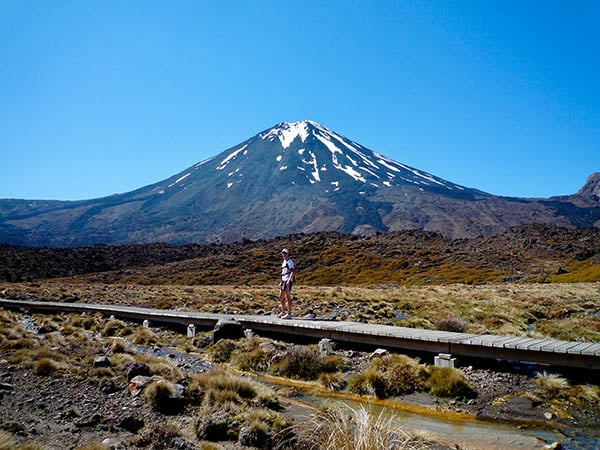
Soda Springs to South Crater
This section is the first of two big climbs on the Crossing.
From Soda Springs the track heads to the top of the Mangatepopo Saddle. This climb is often referred to as the Devil's Staircase.
It should be renamed Stairway to Heaven, as there're almost enough steps to reach heaven.
The views from the top are out of this world.
This section is 1.6km and ascends 280m. This gives an average gradient of 18% or 10 degrees.
On average it takes between 45 minutes and 60 minutes to complete the Mangatepopo Saddle (Devil's Staircase) climb.
The track underfoot is constructed to a high standard and is mostly stepped.
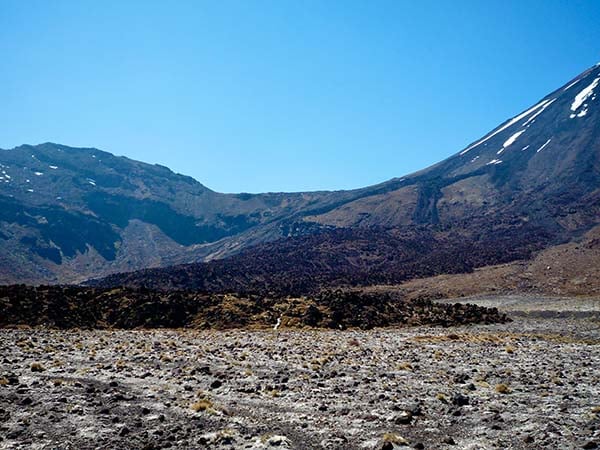
South Crater
The South Crater spans from the top of the Mangatepopo Saddle (Devil's Staircase) to the start of the Red Crater climb.
The South Crater is 1km across. It's flat and a welcome relief from the first climb.
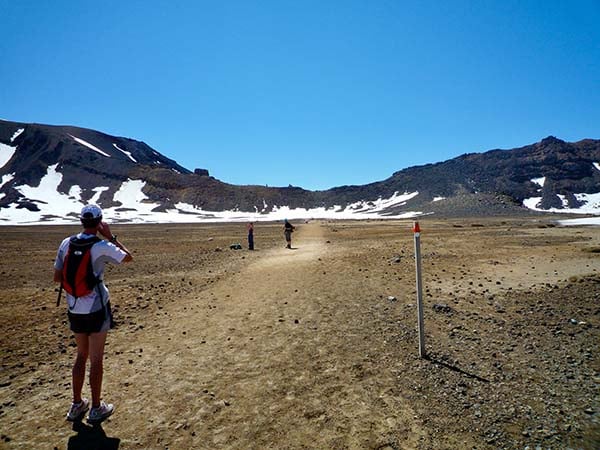
South Crater to the top of Red Crater
This section is the second and last big climb on the Crossing.
The Red Crater climb is 1km and ascends 188m. This gives it an average gradient of 19% or 11 degrees.
On average it takes between 45 minutes and 60 minutes to complete.
The middle section of the Red Crater climb is steep with slippery loose gravel in places.
This section is 305m and ascends 105m which gives an average gradient of 34% or 19 degrees. Your heart and lungs will be pumping here.
The top of the Red Crater ridge is the highpoint of the Tongariro Crossing at 1868m above sea level.
At this point the terrain falls away steeply on either side of the track.
Although the peak is 15m wide it can feel relatively narrow in strong winds.
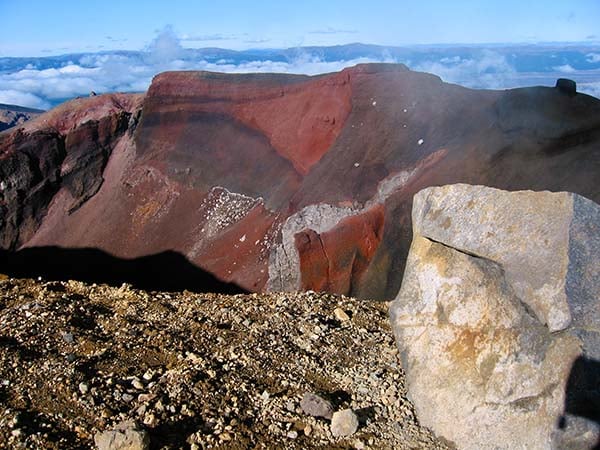
Red Crater to Emerald Lakes
From the Red Crater peak the tracks drops 123m over 330m to the Emerald Lakes. Which is an average gradient of 37% or 20 degrees.
This part of the track is loose scree. Many hikers prefer to use a stick or poles to help themselves down this section.
Coming down from the Red Crater can be fun, if you can let yourself go with the flow.
But don't be surprised if you end up on your bum at least once.
The Emerald Lakes are stunning. This is a great place to stop for a rest if the weather is fine.
Note, the Emerald Lakes and the Blue Lake are Tāpu (sacred) to Ngāti Tūwharetoa and they politely ask you respect this by not touching them.
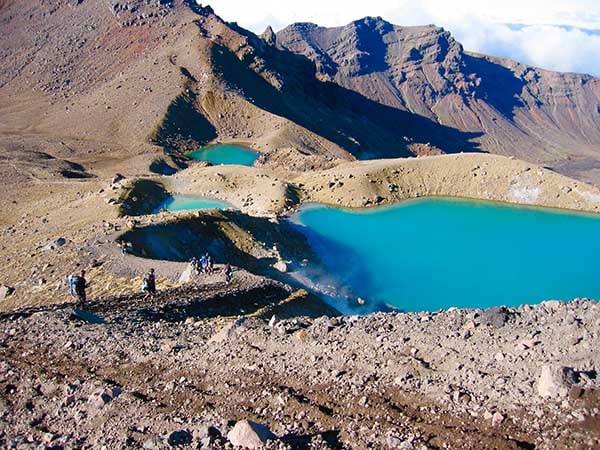
Central Crater
From here the track travels 1km across the flat Central Crater and up a small rise to the Blue Lake.
Another nice place for a rest, and maybe some lunch.
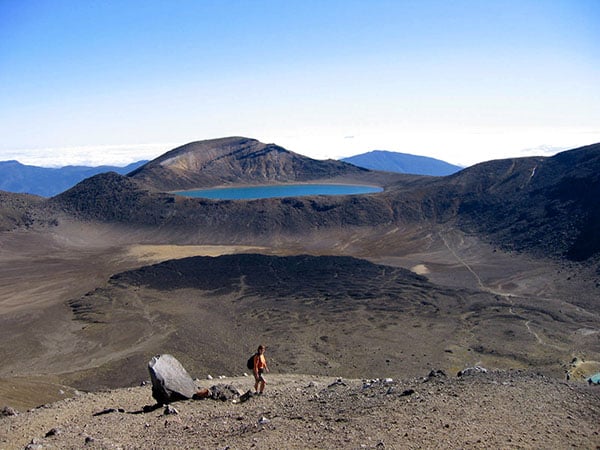
Blue Lake to Ketetahi finish
Once you reach the Blue Lake all the climbing is finished. It's a little too soon to celebrate though.
Many people find the long 9km down hill hard work. It can be testing on the quadriceps and knees.
The spectacular views across Lake Rotoira, Lake Taupo, and surrounding peaks do help.
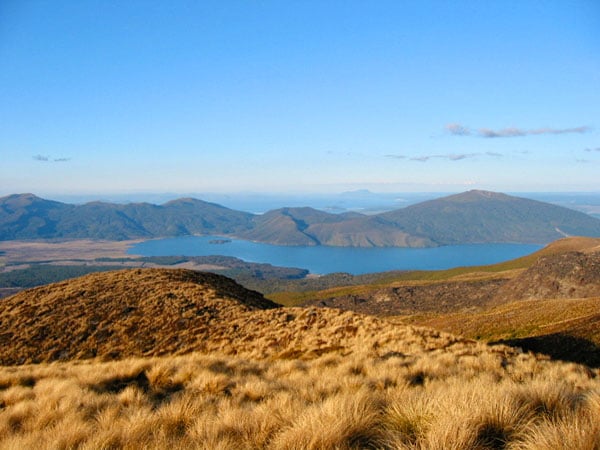
PRO TIP: the sign at the site of the old Ketetahi Hut says 1.5 hours to the finish. This section normally takes 2 hours for most people.
If you're looking for a detailed track description and the geology of the Tongariro Crossing you'll find it here.
For your convenience download the PDF version
Click the button below and we'll email the PDF version to you.
Tongariro Crossing Map
Here's a topographical map of the Tongariro Alpine Crossing.
Click on the Download PDF button below for highest quality printing.
Please note, this map is produced for Discovery Lodge. The drop off times and pick up times are particular Discovery.
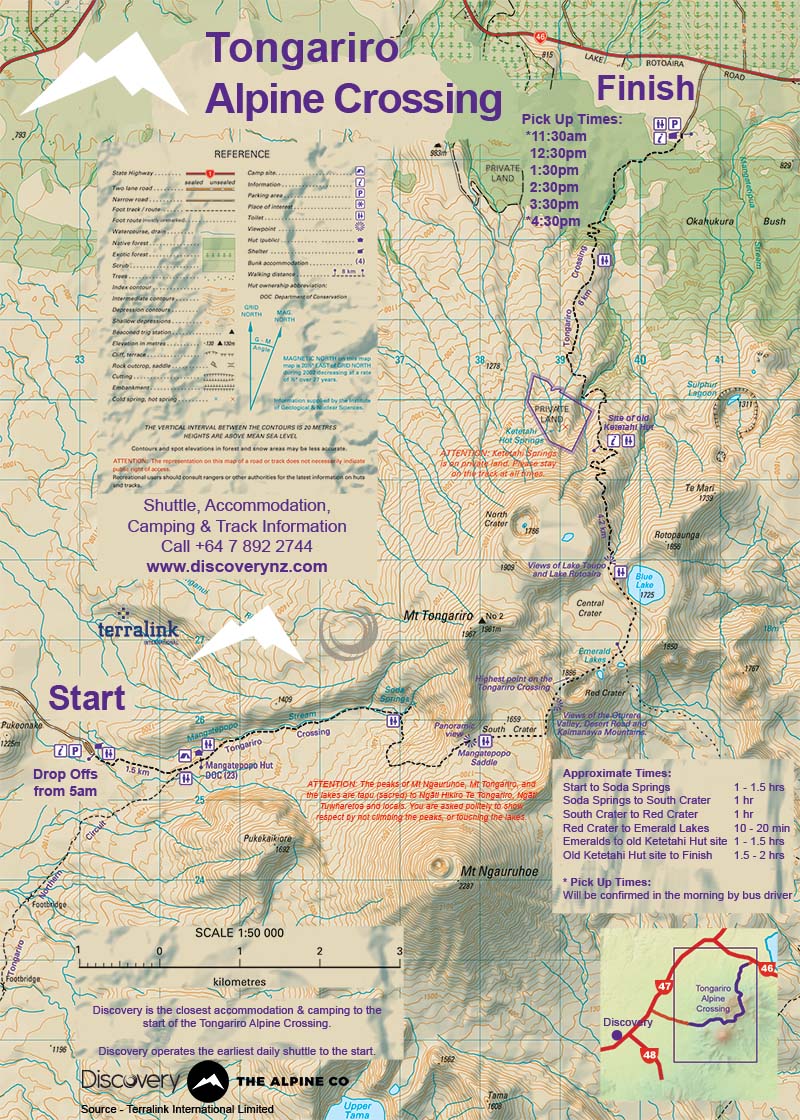
Download high quality PDF version of this map
Click the button below and we'll email the PDF version to you.
Tongariro Crossing Elevations
Tongariro Crossing elevations, ascent and descent.
All heights are above mean sea level (AMSL).
| Metres | Feet | |
| Mangatepopo start | 1120 m | 3675 ft |
| Top of Red Crater (highest point on the track) | 1868 m | 6129 ft |
| Ketetahi finish | 760 m | 2493 ft |
| Total ascent | 748 m | 2454 ft |
| Total descent | 1108 m | 3636 ft |
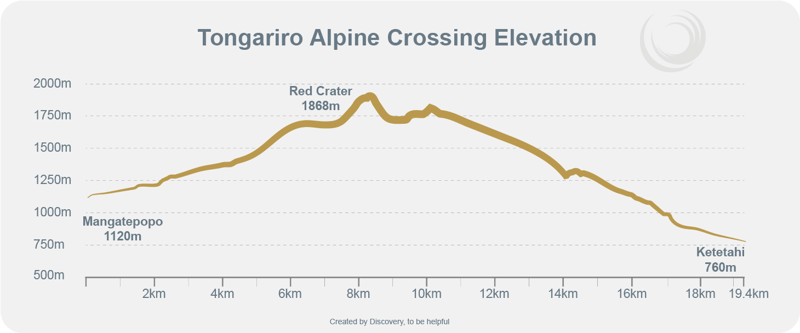
For your convenience download the PDF version
Click the button below and we'll email the PDF version to you.
Planning your Tongariro Crossing adventure: what you need to know
The Crossing is a point to point track
The Tongariro Crossing hike starts at the Mangatepopo road end and finishes at the Ketetahi road end.
The Crossing is point to point so you need to plan logistics around drop offs and pick ups.
The easiest and most convenient way to organise logistics is to use a shuttle.
More about shuttle companies below.
Another option is to have a friend or family member drop you off and pick you up.
Car parking is limited
There is minimal car parking at the Mangatepopo start and the Ketetahi finish.
A four hour time limit applies to the Mangatepopo and Ketetahi carparks from Labour weekend to the 30th April.
The reason for this is to prevent traffic congestion on busy days.
Before the four hour limit was put in place the congestion was worse than Auckland. Not a good way to start a mountain adventure.
Average time to complete the Crossing
The average walking time for the Crossing is between 5.5 hours and 6 hours.
Add a morning tea break, lunch and 200+ photos and it will take around 7 to 8 hours to complete the walk.
Your fitness, walking pace and how many stops you make will determine how long it takes you.
The right gear is a must
Packing the right gear is essential.
The weather can change very quickly on the Tongariro Crossing.
The weather forecast can be completely wrong.
This means you always need to prepare for bad weather, and hot sunshine.
See below for gear list.
The peaks are Tapu (sacred)
The peaks of Mt Ngauruhoe, Mt Tongariro, and the lakes are tapu (sacred) to Ngāti Hikiro Te Tongariro, Ngāti Tuwharetoa and locals. You are politely asked to show respect by not climbing the peaks, or touching the lakes.
Older maps show the side tracks to Mt Tongariro and Mt Ngauruhoe. These tracks have been closed by Department of Conservation.
PRO TIPS:
1. Be prepared for all weather conditions and plan a backup day for the hike.
2. Have a plan B if the weather prevents you from doing the Crossing. There're some great alternatives to doing the Tongariro Crossing if the weather is poor.
For your convenience download the PDF version
Click the button below and we'll email the PDF version to you.
Hazards, risks and problems
Volcanic activity is possible
The Tongariro National Park is an active volcanic area.
It's highly unlikely an eruption will happen while you're hiking, but it is possible.
The Te Maari Crater eruption of 2012 happened without notice.
Geological and Nuclear Sciences (GNS) monitor volcanic activity at different sites around the Tongariro National Park.
Department of Conservation will close the track during heightened volcanic unrest.
Home of alpine weather
Alpine weather can change rapidly.
Tongariro weather can be unpredictable. The weather forecasts can be wrong.
A hot sunny day can turn into a freezing wet day with little warning.
One minute you can be enjoying sunshine and warmth. The next minute rushing to get your rain jacket and jersey on.
This cannot be stressed enough.
Even in the middle of summer it's essential to pack gear for all weather.
Snow and ice
The Tongariro Alpine Crossing is an alpine environment.
Snow is present on the track during winter months of July, August and September.
Snow can also be present on the track during the shoulder months of May, June, October and November.
Snow and ice can present significant risk on the track.
When the Red Crater is covered in snow and ice you need an ice axe and crampons to traverse it safely. You also need alpine experience or you need to go with a guide.
If you don't have alpine experience, the only safe way to enjoy a snowy Crossing is to go with a guide.
Loose scree, uneven terrain and hundreds of steps
Footing on parts of the track is uneven, which you would expect in the mountains.
There's a steep section of loose scree from the top of Red Crater to the Emerald lakes.
Hiking boots are recommended to give more support.
Running shoes or trainers are suitable for fit hikers with strong ankles. However, if the weather is poor boots will always be the better option.
There are hundreds of steps going up the Mangatepopo Saddle (Devils staircase). There are also hundreds of steps going down from the Blue Lake to just below the bush line.
Not enough respect for the alpine environment
Hikers have died on the Crossing because of poor decision making and inadequate gear.
The Tongariro Crossing passes over mountains.
The Tongariro mountains are highly susceptible to hash weather conditions.
Always go prepared for the worst weather. And yes, even when the forecast is for fine weather.
Poor advice given about weather conditions
If the weather forecast is marginal or poor it's critical to receive expert weather advice.
It should be tailored for your level of experience, your physical condition and the gear you have.
Hikers will generally receive this advice from shuttle drivers. Not all shuttle drivers are equal.
Some shuttle drivers have many years of experience with the weather and can give expert advice.
Unfortunately there are those who are inexperienced, and some who don't care enough.
Booking a shuttle with a no refund policy
It should be easy and painless to cancel your shuttle at the last moment.
All shuttle companies should offer a full refund if you cancel the morning of the hike.
But most do not.
Most shuttle companies don't allow you to cancel the morning of your hike, and receive a full refund.
There should be no pressure for you to do the Crossing if you have doubts.
You might not feel comfortable about the weather.
You might not feel you're physically up to doing the hike.
Or there could be another reason why you don't wish to do the hike.
Compare Tongariro Crossing shuttle cancellation policies here.
Waiting for your shuttle after the hike
If you're a fast hiker you could end up finishing the hike early.
This means waiting for your shuttle. Sometimes you can be waiting hours.
Before you book your shuttle find out when the earliest shuttle pick up is.
Running for your shuttle after the hike
If you're a slow hiker you could end up having to rush to catch your shuttle.
The Tongariro Alpine Crossing it too good to rush.
Before you book your shuttle find out when the latest pick up is.
Crowds and crowds
Before covid, the Tongariro Alpine Crossing could get extremely crowded.
A busy day would have over 3000 people hiking the trail !
Parts of the Crossing are single track where you walk one person behind the other.
The walking pace slows to the slowest person in front of you. Passing others is difficult.
As hikers in front approach steeper sections the line of hikers behind come to a crawl.
Another consequence of hiking the Crossing with the crowd is the long queues for toilets. Waiting times of over half an hour have been reported on busy days.
Scenic photo opportunities without people in the frame will be limited on these busy days.
To avoid the crowds you need to start early. Really early.
Dusty Ketetahi Road
If you take a one way shuttle you'll need to walk to the end of the Ketetahi Road.
This is an extra 800m of gravel road after you finish the Crossing.
During dry weather this road gets very dusty.
Unfortunately most vehicles driving up this road go too fast, and hikers get covered in dust.
Long downhill
The section of track from the Blue Lake to the finish is 9 kilometres of downhill.
Many hikers complain about this section. Saying it is physically harder than the uphill on the Crossing.
This long downhill can be especially challenging for those with problem knees.
Plastic matting
On the long downhill from the Blue Lake to the finish there are sections of plastic track matting.
This is designed to contain gravel on the track and stop water erosion.
It works well for this purpose.
However the plastic matting can be a trip hazard.
The plastic can also become slippery when wet.
For your convenience download the PDF version
Click the button below and we'll email the PDF version to you.
Tongariro Crossing weather: what you need to know
Tongariro's changeable weather
The weather can change quickly in the Tongariro National Park. From a hot sunny day to cold, wet and windy. This can happen in minutes.
Weather forecasts are only a prediction of what the weather might do. This means it can be completely wrong and often is, particularly here in the Tongariro mountains.
It's critical to prepare for all weather when hiking the Tongariro Alpine Crossing.
This means packing warm layers and water proof gear even if the forecast is for fine weather.
And pack sun protection when the weather forecast is poor.
Here's more detailed information about how to prepare for Tongariro Crossing weather.
Planning for good weather
A note about planning the Crossing for good weather: it's almost impossible more than a week out.
Two days prior is a challenge.
We're talking mountain weather here. It can be unpredictable and changeable.
The only forecast I put faith in is the forecast first thing in the morning for that day.
The forecast depends on the approaching weather pattern for New Zealand. If the weather is stable it's easier to predict. If it's unstable it's difficult to predict.
Weather forecasts
Now you know the important stuff, here's four weather forecast sites to check.
Tongariro Alpine Crossing weather forecast sites:
Niwa and the Metservice sites forecast the weather on Red Crater, the highest altitude on the Crossing. This is helpful, because poor weather can make it challenging to traverse this part of the track.
When reading the Niwa forecast take note of the average wind speed, wind chill and rain. Visibility is handy to know as well.
The Metservice shows the wind chill and the rain on Red Crater.
The surface pressure map on this site shows the bigger picture.
You need experience to fully understand mountain forecasts. It's a good idea to ask someone for advice if you don't have this experience.
Is the weather good enough to do the Tongariro Crossing today?
The Niwa web site shows the Department of Conservation weather advisory.
When certain poor weather parameters are forecast DOC advises against hiking the Crossing.
There will be signage at the start of the hike displaying DOC's recommendation not to hike.
There will also be digital signage on the way to the Crossing.
If the weather forecast is marginal, it's your personal choice to go or not.
You'll need to consider your level of experience and the quality of your gear.
If you have little experience, or cheap gear consider doing an alternative hike at a lower altitude.
PRO TIP: If you're unsure about the weather forecast please talk to someone with experience.
Best Tongariro Crossing Weather Forecasts
Tongariro Crossing shuttles
Why need a shuttle ?
The Tongariro Alpine Crossing is a point to point hike. It's not a circuit. The track starts on the western side of Mt Tongariro and finishes on the lower northern slopes.
There's limited car parking at the Mangatepopo start, and at the Ketetahi finish. A 4 hour time limit is in place between late October and the end of April.
Most hikers use shuttle companies for drop offs in the morning, and pick ups in the afternoon.
There are two types of shuttle services:
-
Return shuttles
-
One way shuttles.
A return shuttle will pick you up at your accommodation in the morning and take you to the start. In the afternoon the shuttle will pick you up from the finish and take you back to your accommodation. Return shuttles also operate from the public car park in National Park Village.
One way shuttles pick you up from Ketetahi in the morning and take you to the start. You drive your car to Ketetahi in the morning and park it there. You then walk back to your car from the start.
Both these services have pros and cons. Compare Tongariro Crossing return shuttles and one way shuttles.
Below is a list of established shuttle companies. Most operate return shuttles and some operate one way shuttles.
Compare Tongariro Crossing shuttles here.
Here's a list of Tongariro Crossing Shuttle companies:
Tongariro Crossing Track Transport
Doing the Tongariro Crossing without a shuttle
Doing the Crossing without using a shuttle is possible.
If you have a friend or family member who can shuttle you to and from the Crossing this can work.
The only other option is to take your chances and hitch hike. You'll hitch hike to the start, and then hitch back to your accommodation from the finish.
Don't expect shuttle companies to stop for you though.
For your convenience download the PDF version
Click the button below and we'll email the PDF version to you.
Villages and towns near the Tongariro Crossing
Here's a list of towns and villages close to the Tongariro Alpine Crossing, and distances to the Mangatepopo start:
| Distance to start | Views of volcanoes | |
| Whakapapa | 16 km | Yes |
| National Park | 19 km | Yes |
| Owhango | 40 km | No |
| Taumarunui | 62 km | No |
| Raetihi | 53 km | Yes |
| Ohakune | 54 km | Yes |
| Turangi | 43 km | No |
| Taupo | 93 km | Yes |
For your convenience download the PDF version
Click the button below and we'll email the PDF version to you.
Tongariro Crossing accommodation: close to the start
Here's a list of accommodation close to the Tongariro Alpine Crossing start
| Distance to start | Views of all three volcanoes | Tripadvisor | |
| Adventure Lodge | 20 km | No | Excellent |
| Discovery | 11 km | Yes | Excellent |
| Mountain Heights | 21 km | No | Excellent |
| Pipers Lodge | 19 km | No | Excellent |
| The Crossing Backpackers | 25 km | No | Excellent |
| Tongariro Crossing Lodge | 20 km | No | Excellent |
| Tongariro Springs Suites | 25 km | No | Excellent |
| Wood Pigeon Lodge | 28 km | Yes | Excellent |
| Chateau Tongariro | 16 km | Yes | Very good |
| Howards Lodge | 20 km | No | Very good |
| Manowhenua Lodge | 20 km | No | Very good |
| National Park Backpackers | 19 km | Yes | Very good |
| Plateau Lodge | 20 km | No | Very good |
| Pukenui Lodge | 19 km | Yes | Very good |
| Skotel | 17 km | Yes | Very good |
| The Park Hotel | 19 km | Yes | Very good |
| Tongariro Holiday Park | 19 km | No | Very good |
| Whakapapa Holiday Park | 16 km | No | Very good |
All the above accommodations have years of experience with guests hiking the Crossing and can organise a shuttle for you.
Tongariro Crossing camping: close to the start
Here's a list of camping grounds close to the Tongariro Alpine Crossing
| Distance to start | Views of all three volcanoes | Tripadvisor | |
| Discovery | 11 km | Yes | Excellent |
| Tongariro Holiday Park | 19 km | No | Very good |
| Whakapapa Holiday Park | 16 km | No | Very good |
All the above camp grounds have years of experience with guests hiking the Crossing and can organise a shuttle for you.
Tongariro Crossing seasons
Summer hiking months
The most popular months to hike the Tongariro Crossing are from November through to April.
During these warmer months the track is clear of snow and ice.
See below for more on enjoying the Crossing during winter.
Winter alpine hiking months
Snow and ice covers the Tongariro Crossing during July to September. Depending on the winter, snow and ice can still cover the track in October.
You will need alpine experience to hike the Crossing during these snowy months.
If you don't have experience you can hike the Crossing with a guide. This can be an exhilarating experience.
See more below.
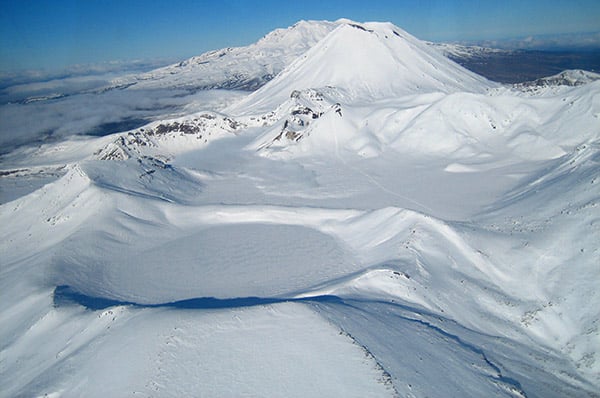
Shoulder months
It's possible to enjoy the Crossing during the shoulder months of October, May and June. But only if the track is clear of snow and ice.
These months are quiet compared to the summer months. So a good time to hike the Crossing if you prefer to hike in solitude.
Every winter season is different. Some years the Crossing has snow on the track as late as early November. Other years the snow is gone by early October.
Some years the winter snow arrives late making it possible to hike the Crossing during May and June.
A word of warning: The weather for May and June can be changeable and difficult to predict.
You'll need to prepare for winter weather.
It's a bad idea to hike the Crossing during these months if you don't have the best quality alpine hiking gear.
It can be a challenge to find a shuttle for drop off and pick up during these quiet months. Many shuttle companies don't operate during these months.
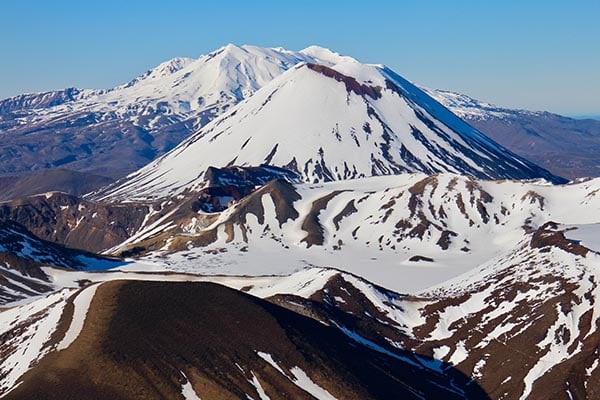
The picture above was taken on the 19th October 2018. The Red Crater ridge was clear of snow and ice. The Emerald Lakes and the Blue Lake were still frozen.
For your convenience download the PDF version
Click the button below and we'll email the PDF version to you.
Tongariro Crossing winter experience
The big difference between a summer Crossing and a winter Crossing is snow.
Snow and ice cover the landscape during July to September and part of October.
For these months white snow blankets many of the geological features including the South Crater, Red Crater, Emerald Lakes, Central Crater and the Blue Lake.
On a fine day a winter Tongariro Crossing journey can be spectacular. You'll marvel at wide ranging views of the volcanoes and the surrounding land forms.
Alpine experience is necessary to traverse the track in winter. You'll need ice axe and crampons.
No alpine experience, or gear? No worries.
Go with a guiding company. You do need a good level of fitness as hiking over snow can be tiring.
You don't need any snow, ice, crampon or ice axe experience what so ever. The guiding company will provide the gear and coach you along your journey.
Here's two local guiding companies to contact:
During the summer months the Crossing is clear of snow. All the volcanic features are in full view.
PRO TIP: Compare cancellation policies before you book.
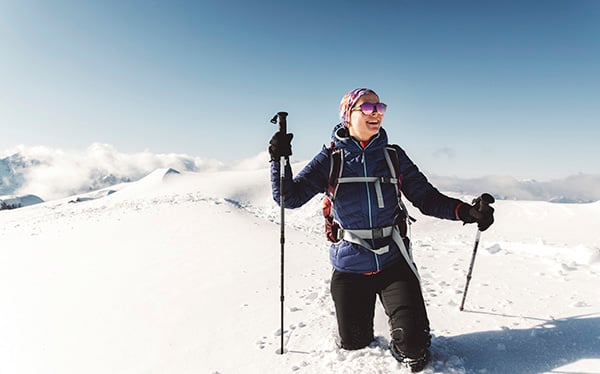
For your convenience download the PDF version
Click the button below and we'll email the PDF version to you.
When is the best time to start the hike
The most popular time to start the hike is between 7am and 9am. On a busy day there are hundreds of people starting during these hours. It can be hectic.
Starting later in the day is less popular. The latest shuttles to the start are around 10am.
Starting later is a good way to avoid the larger crowds, but on a hot day you'll feel the heat, especially on the two big climbs.
If you're considering starting late be sure to check the latest shuttle pick up at the end of the day. It's a long walk to anywhere from Ketetahi if you miss your bus.
Another option is to start early. This option has gained popularity over the last few years.
Starting at 6am has almost become the new 7:30 am. On a busy day more than a hundred hikers can be starting a little after 6am.
Another option is to start even earlier, around 5am.
This option is not so popular, because most people don't like getting out of bed early.
The advantages of going this early are:
-
Experiencing Tongariro in peace and quiet
-
Possible to witness a beautiful mountain sunrise
-
Able to complete the two big climbs before the heat of the day
-
Finish the hike earlier in the day
A dawn start can be spectacular on a fine morning. There's something special about being in the mountains first thing.
More information about the earliest Tongariro Crossing shuttle can be found here.
For your convenience download the PDF version
Click the button below and we'll email the PDF version to you.
Tongariro Crossing hiking gear
Tongariro Crossing weather can be unpredictable. The weather can change from sunshine to rain and cold in minutes.
For this reason it's critical you pack gear for all weather.
Here's a list of essential gear to hike the Tongariro Alpine Crossing:
- Good quality water proof jacket
- Plenty of warm layers
- Warm hat
- Sturdy footwear
- Food and water
- Sun protection
- Map
It's good to take a mobile phone as well.
More detailed information about essential gear needed to hike the Tongariro Crossing can be found here.
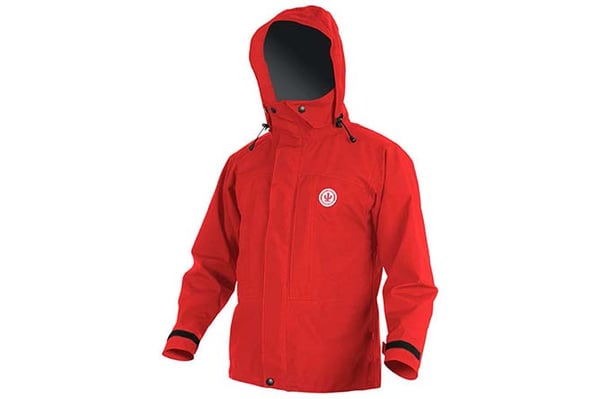
For your convenience download the PDF version
Click the button below and we'll email the PDF version to you.
Food and water
There's no food or drinkable water on the Tongariro Alpine Crossing. There's no coffee, no beer and no ice cream.
This means you need to take enough food and water to last you the hike.
1.5 litres of water is generally enough as long as you are well hydrated before you start out.
I recommend drinking plenty of water the day before and in the morning before your hike. There are toilets at the start and along the way.
It's also a good idea to have a high energy breakfast before you head out into the mountains for the day.
For your convenience download the PDF version
Click the button below and we'll email the PDF version to you.
Tongariro Crossing alternatives
Don't be sad if the weather is not good enough to hike the Tongariro Crossing.
You can still get out and make the most of your mountain adventure.
There are great alternatives which can be enjoyed even if the weather is poor.
Here's a short list:
- Tama Lakes
- Taranaki Falls
- Silica Rapids
- Whakapapaiti
- Lake Rotopounamu
You'll find more information on alternatives to the Tongariro Crossing here.
Tama Lakes
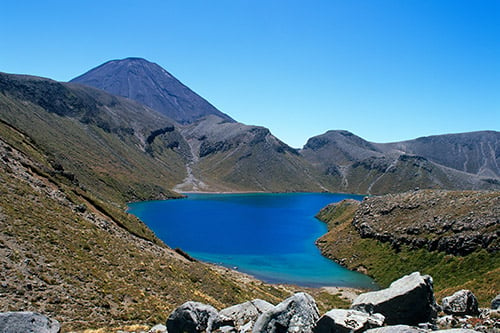
From Our Blog
Stay up to date with what is new in our industry, learn more about the upcoming products and events.
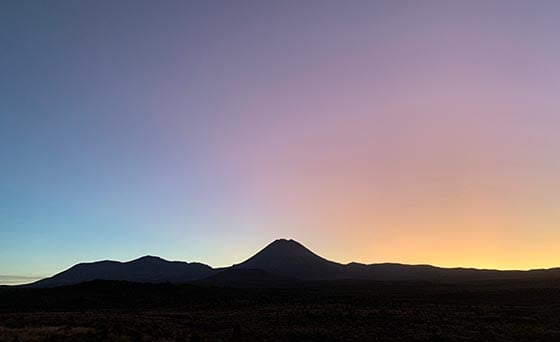
Compare Tongariro Crossing shuttles: for your epic adventure
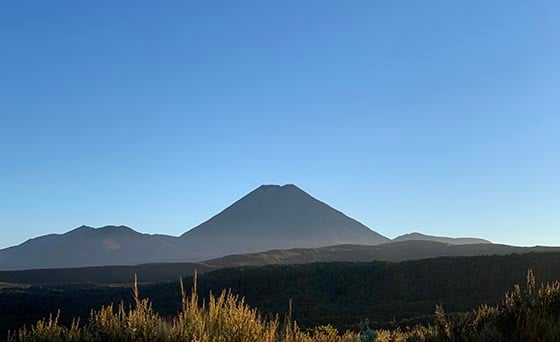
One way Tongariro Crossing shuttle v's return shuttle
